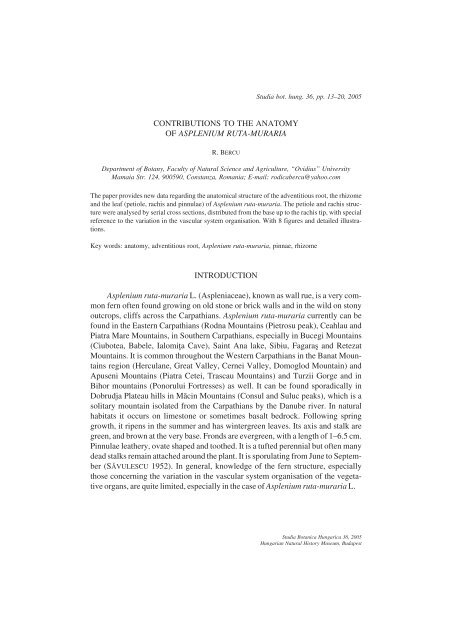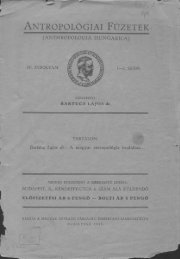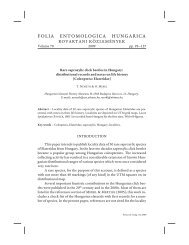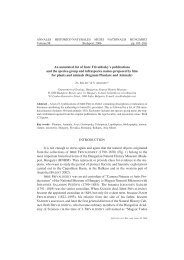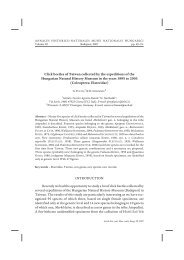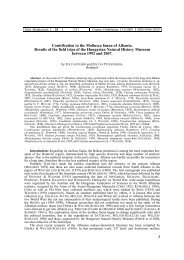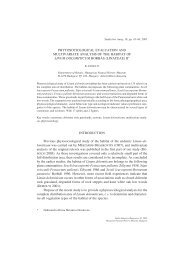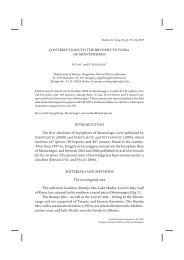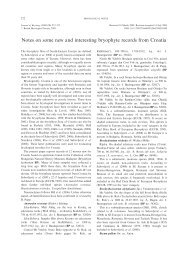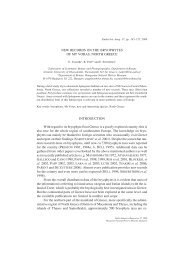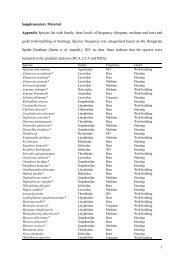CONTRIBUTIONS TO THE ANATOMY OF ASPLENIUM RUTA ...
CONTRIBUTIONS TO THE ANATOMY OF ASPLENIUM RUTA ...
CONTRIBUTIONS TO THE ANATOMY OF ASPLENIUM RUTA ...
- No tags were found...
Create successful ePaper yourself
Turn your PDF publications into a flip-book with our unique Google optimized e-Paper software.
Studia bot. hung. 36, pp. 13–20, 2005<strong>CONTRIBUTIONS</strong> <strong>TO</strong> <strong>THE</strong> ANA<strong>TO</strong>MY<strong>OF</strong> <strong>ASPLENIUM</strong> <strong>RUTA</strong>-MURARIAR. BERCUDepartment of Botany, Faculty of Natural Science and Agriculture, “Ovidius” UniversityMamaia Str. 124, 900590, Constanza, Romania; E-mail: rodicabercu@yahoo.comThe paper provides new data regarding the anatomical structure of the adventitious root, the rhizomeand the leaf (petiole, rachis and pinnulae) of Asplenium ruta-muraria. The petiole and rachis structurewere analysed by serial cross sections, distributed from the base up to the rachis tip, with specialreference to the variation in the vascular system organisation. With 8 figures and detailed illustrations.Key words: anatomy, adventitious root, Asplenium ruta-muraria, pinnae, rhizomeINTRODUCTIONAsplenium ruta-muraria L. (Aspleniaceae), known as wall rue, is a very commonfern often found growing on old stone or brick walls and in the wild on stonyoutcrops, cliffs across the Carpathians. Asplenium ruta-muraria currently can befound in the Eastern Carpathians (Rodna Mountains (Pietrosu peak), Ceahlau andPiatra Mare Mountains, in Southern Carpathians, especially in Bucegi Mountains(Ciubotea, Babele, Ialomiţa Cave), Saint Ana lake, Sibiu, Fagaraş and RetezatMountains. It is common throughout the Western Carpathians in the Banat Mountainsregion (Herculane, Great Valley, Cernei Valley, Domoglod Mountain) andApuseni Mountains (Piatra Cetei, Trascau Mountains) and Turzii Gorge and inBihor mountains (Ponorului Fortresses) as well. It can be found sporadically inDobrudja Plateau hills in Măcin Mountains (Consul and Suluc peaks), which is asolitary mountain isolated from the Carpathians by the Danube river. In naturalhabitats it occurs on limestone or sometimes basalt bedrock. Following springgrowth, it ripens in the summer and has wintergreen leaves. Its axis and stalk aregreen, and brown at the very base. Fronds are evergreen, with a length of 1–6.5 cm.Pinnulae leathery, ovate shaped and toothed. It is a tufted perennial but often manydead stalks remain attached around the plant. It is sporulating from June to September(SĂVULESCU 1952). In general, knowledge of the fern structure, especiallythose concerning the variation in the vascular system organisation of the vegetativeorgans, are quite limited, especially in the case of Asplenium ruta-muraria L.Studia Botanica Hungarica 36, 2005Hungarian Natural History Museum, Budapest
14 BERCU, R.MATERIAL AND METHODSCross sections of the root, rhizome and leaf were made with a rotary microtome. The sampleswere stained with alum-carmine and iodine green, and were embedded in Canada balsam. The observationswere made with a BIOROM-T bright field microscope, equipped with a <strong>TO</strong>PICA-1006Avideo camera. The microphotographs were obtained from the video camera through a computer.RESULTS AND DISCUSSIONSCross sections of the adventitious root revealed that the cortex is composed of3–4 layers of large parenchyma cells. The inner layers of cortex cells are modifiedand have thick walls. KROEMER (1903) suggested that this wall thickening was theresult of cutinised blade superpositions. Noticed by early authors, the presence ofsuch “curious cells” around the stele has led to the recognition of this tissue belongingto the stele and naming it “sclerenchymatous mass” (RUSSOW 1872, BIER-HORST 1971) or a “stereomic sheath” (DE BARY 1877, OGURA 1938, BERCU 1998a,BERCU et al. 2000) (Figs 1A, B). This configuration has led SCHNEIDER (1996) toinclude this type of root to that of Asplenium.The stele consists of xylem and phloem and is surrounded by the pericycle.The xylem elements are joined together towards the centre by their metaxylemvessels (two for each bundle). The protoxylem vessels (four for each bundle) are inan exarch position and face the pericycle. The phloem sieve cells lacking companioncells are located on either side of the xylem string (Fig. 1B). This attributes tothe adventitious root a diarch structure.Fig. 1. Cross section of the adventitious root. – A: General view of the root (×269). – B: Detail of thestele (×330): C = cortex, Mx = metaxylem, Pc = pericycle, Ph = phloem, Px = protoxylem, St = stele,SS = sclerenchyma sheath. Orig.Studia bot. hung. 36, 2005
16 BERCU, R.Transections of the petiole and rachis cut from the base up to 1.5 cm disclosealmost the same succession of tissues, that is a unistratose epidermis covered bycuticle, a cortex and a stele. Below the epidermis there is the hypodermis, consistingof a few layers of compactly arranged sclerenchyma cells. The hypodermis isinternally followed by a region of ground tissue (Fig. 3B). Remarkable is the abundanceof starch grains in the cortex and the presence of a single packet ofsclerenchymatous cells (Figs 3A, B). The sclerenchyma packet of cells from 2 cmup to the tip of the base is absent (Figs 5–7). The stele is monofascicular, composedof two centrally located metaxylem strings. The phloem surrounds the xylem elements.That attributes to the vascular bundle a hadrocentric structure (Fig. 3C).The two xylem curved strings configuration reveals that initially two vascular bundlesfrom the rhizome join together to form a foliar trace (Figs 2A, 3C).Fig. 3. Cross section of the petiole base. – A: General view (×115). – B: Portion of the epidermis andcortex. – C: The stele (×150): C = cortex, E = epidermis, H = hypodermis, IC = inner cortex, Ph = phloem,Mx = metaxylem, Pc = pericycle, Px = protoxylem Scl = sclerenchyma, St = stele, SG = starch grains,SS = starch sheath. Orig.Studia bot. hung. 36, 2005
ANA<strong>TO</strong>MY <strong>OF</strong> <strong>ASPLENIUM</strong> <strong>RUTA</strong>-MURARIA 17Fig. 4. Cross section of the petiole (1.5 cm from the petiole base). – A: Portion of the epidermis andcortex. – B: The stele (×170): Scl = sclerenchyma. Orig.Fig. 5. Cross section of the petiole (2 cm from the petiole base). – A: Portion of the epidermis and cortex.–B:The stele (×240): E = epidermis, Ed = endodermis, H = hypodermis, IC = inner cortex, Mx =metaxylem, Pc = pericycle, Ph = phloem, Px = protoxylem. Orig.Fig. 6. Cross section of the subterminal rachis. – A: General view (×80). – B: The stele (×180): E =epidermis, Ed = endodermis, Pc = pericycle, Ph = phloem, PT = parenchyma tissue, St = stele, X =xylem. Orig.Studia bot. hung. 36, 2005
18 BERCU, R.Fig. 7. Cross section of the rachis tip (6 cm from the petiole base). – A: General view (×115). – B:Portion of the stele with a pinnulae trace (×266): Pt = pinnulae trace. Orig.The cross section, performed at 1.5 cm from the petiole base, exhibits almostthe same structure but the xylem strings of the monostele are joined, towards thecentre, by their abaxial protoxylem vessels (Figs 4A, B).The cross section cut at 2 cm from the petiole base shows a monofascicularstele, composed of metaxylem vessels arranged in an X-shape, characteristic to theAspleniaceae (OGURA 1972, BIR 1957, BERCU 1998a, BERCU et al. 2000). Thephloem surrounds the xylem elements (Figs 4A, B). The transection of the rachisfrom 2 cm up to 6 cm (from the petiole base) exhibits the same succession of tissuesbut the xylem vessels are in a T-shape arrangement (Figs 5A, B).Fig. 8. Cross section of pinnulae. – A: Portion of the mesophyll and midrib (×205). – B: Portion of thelower epidermis (×250): Cl = chloroplasts, EC = epidermal cell, LE = lower epidermis, O = ostiole,PT = parenchyma tissue, S = stoma, Sp = sporangium, SC = subsidiary cell, ST = spongy tissue, UE =upper epidermis, VB = vascular bundle. Orig.Studia bot. hung. 36, 2005
ANA<strong>TO</strong>MY <strong>OF</strong> <strong>ASPLENIUM</strong> <strong>RUTA</strong>-MURARIA 19The transection of the rachis tip (6 cm from the petiole base) shows that thecentrally located xylem of the stele has a slightly excavated V-shape, surroundedby phloem, the pericycle and endodermis, the latter with parenchymatous sheathvalue (Figs 6A, B) (BERCU 1998b). In the rachis tip two vascular bundles appear,the smaller derived from the rachis stele to form the pinnulae vein (Figs 7A, B).Remarkable is the reduced number of the vascular elements because of the marginalformation of the pinnulae veins. A typical hypodermis is absent (Figs 6A, 7A).The pinnulae appear in cross section to consist of a single layer of irregularlyarranged epidermal cells, covered by a thin cuticle (Fig. 8A). On the lower epidermisnumerous polycytic and anomocytic stomata occur (VAN CO<strong>THE</strong>M 1970,DILCHER 1974). The epidermal cells possess wrinkled anticlinal walls (Fig. 8B).The mesophyll is differentiated into palisade tissue (arranged into one row)and spongy tissue. The latter consists of a number of branched and lobed cells arrangedinto 2–3 rows, forming a system of intercellular spaces (POIRAULT 1893).The poorly developed vascular system of the midrib is represented by a hadrocentricvascular bundle with xylem in a centre position. The bundle is surroundedby a bundle sheath (Fig. 8A).CONCLUSIONSThe root of Asplenium ruta-muraria L. has a diarch structure with modifiedlayers of cortex around the stele and a monolayered pericycle. The rhizome (analysedby serial transections) consists of an epidermis, a parenchymatous cortex anda dictyostele, containing a variable number of meristeles. The leaf petiole and rachisexhibit a differential cortex (a sclerenchymatous hypodermis and an inner parenchyma).Close to the rachis tip, the sclerenchymatous hypodermis disappears. Remarkableare the variations in the organisation of the vascular system. The vascularsystem of the leaf petiole base is monostelic possessing two xylem strings surroundedby phloem elements, while up to the subterminal rachis the monofascicularstele is X-, and than T-shaped. The pinnulae have a heterogeneousmesophyll composed of palisade and spongy tissue, the latter consisting branchedand lobed cells. The midrib has a hadrocentric structure. The lower epidermis continuityis broken by a number of stomata of the polycytic and anomocytic type.REFERENCESBERCU, R. (1998a): Anatomical modifications of the corm stele in fern Asplenium septentrionale(L.) Hoffm. – Šumarstvo, Journal of Forestry, Belgrade 1: 35–40.Studia bot. hung. 36, 2005
20 BERCU, R.BERCU, R. (1998b): Observation on the anatomy in native ferns Ceterach officinarum DC., Aspleniumscolopendrium L. and Polypodium vulgare L. – Contribuţii botanice, Cluj-Napoca 2:113–119. (1997/98)BERCU, R., BAVARU, E. and JIANU, D. L. (2000): Anatomy of the rhizome in fern Asplenium virideHuds. – Annals of Natural Science, Series Biology and Ecology, “Ovidius” University 4: 1–2.BIERHORST, D. W. (1971): Morphology of Vascular Plants. – Collier and MacMillan Ltd., Londonand New York, pp. 296–298, 300–304.BIR, S. S. (1957): Stelar anatomy of Indian Aspleniaceae. – Proceed. Ind. Sci. Congr. Association,Calcutta, 44: 232.DE BARY, A. (1877): Vergleichende Anatomie der Vegetationsorgane der Phanerogamen und Farne.–Wilhelm Engelmann, Leipzig, 664 pp.DILCHER, D. L. (1974): Approaches to the identification Angiosperm leaf remains. – Bot. Rev. 40:1–157.KROEMER, K. (1903): Wurzelhaut, Hypodermis und Endodermis der Angiospermenwurzel. – Biblioth.Bot. 12: 151.OGURA, Y. (1938): Anatomie der Vegetationsorgane der Pteridophyten. Handbuch der Pflanzenanatomie.– Gebrüder Borntraeger, Berlin, pp.128–140.OGURA, Y. (1972): Comparative anatomy of vegetative organs of Pteridophytes. – In: Handbuch derPflanzenanatomie. Gebrüder Borntraeger, Berlin, pp. 325–395.POIRAULT, G. (1893): Recherches anatomiques sur les Cryptogames vasculaires. – Ann. Sci. Nat.Bot., Paris 7(18): 113–256.RUSSOW, E. (1872): Vergleichende Untersuchungen betreffend die Histologie der vegetativen undsporenbildenden Organe und die Entwicklung der Sporen der Leitbündel-Kryptogamen. –Mém. Acad. Imp. Sc., St. Petersbourg 7(19): 1–207.SĂVULESCU, T. (ed.) (1952): Flora României. I. – Ed. Academiei Române, Bucureşti, pp. 133–135.SCHNEIDER, H. (1996): The root anatomy of ferns: a comparative study. Pteridology in perspective.– Royal Botanical Garden, Kew, pp. 271–283.VAN CO<strong>THE</strong>M, W. J. R. (1970): A classification of stomatal types. – Bot. Linn. Soc. 83(3): 253–246.(Received: 19 July, 2004)Studia bot. hung. 36, 2005


